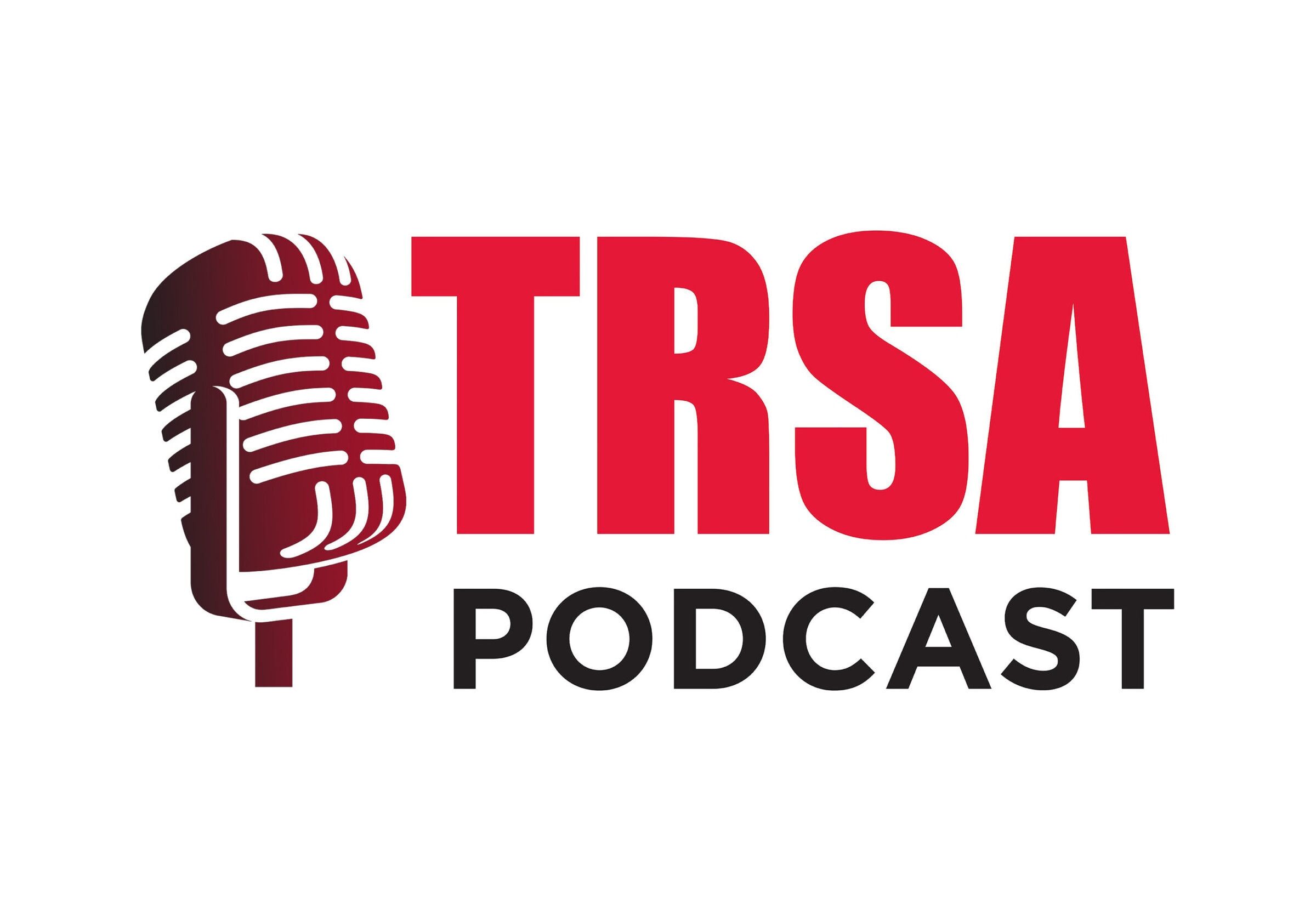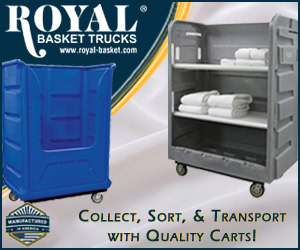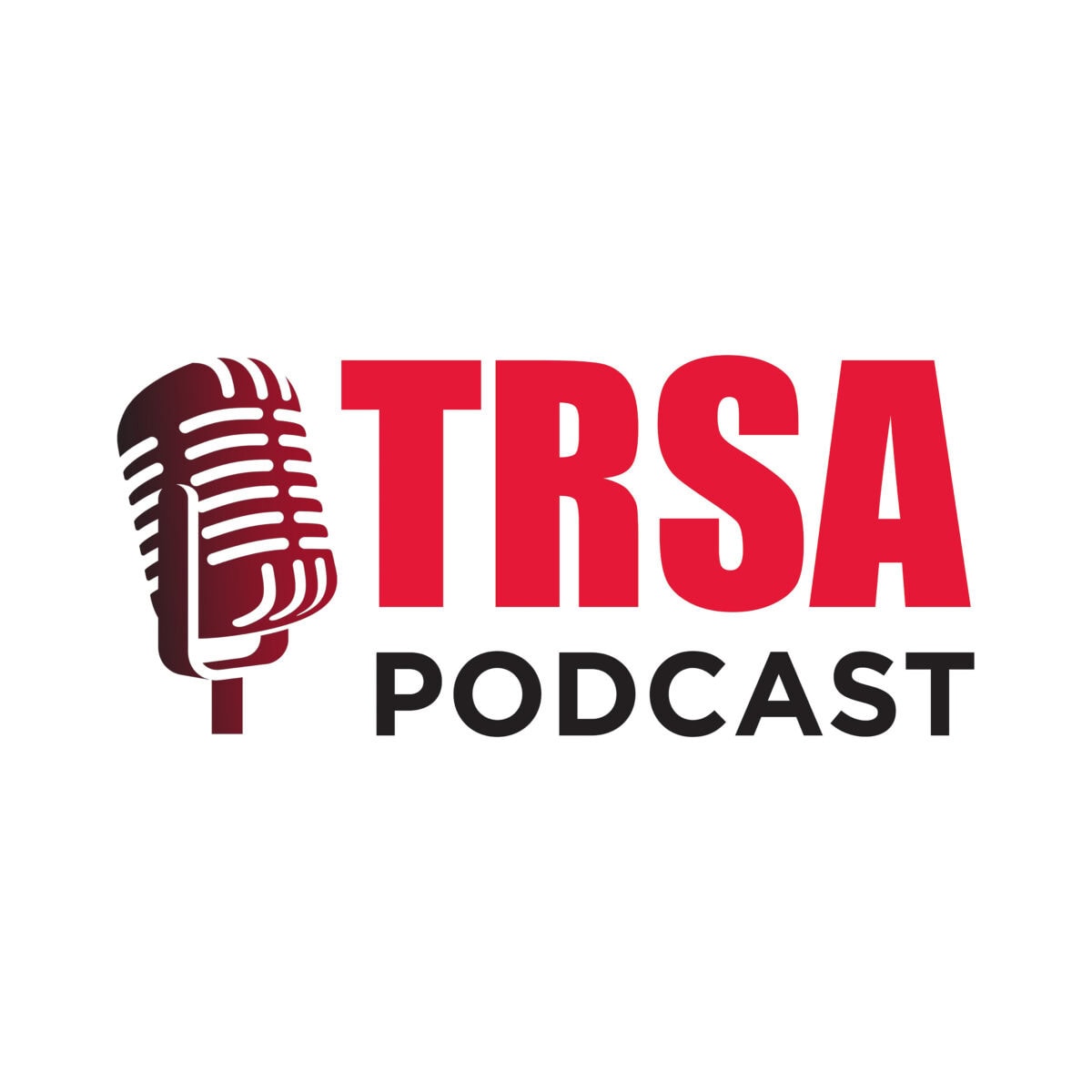 Larry Erickson, the chief technology officer at Kannegiesser North America, discusses breakthroughs in artificial intelligence (AI), the importance of collecting data and using it to improve plant productivity and efficiency, as well as technology that will shape the future of laundry plant operations. View the latest technology in action at Clean Show 2025. For more information, visit www.thecleanshow.com.
Larry Erickson, the chief technology officer at Kannegiesser North America, discusses breakthroughs in artificial intelligence (AI), the importance of collecting data and using it to improve plant productivity and efficiency, as well as technology that will shape the future of laundry plant operations. View the latest technology in action at Clean Show 2025. For more information, visit www.thecleanshow.com.
This Episode is Sponsored by:
Jason Risley: I’m Jason Risley, the host of TRSA’s Linen, Uniform and Facility Services Podcast. Today’s episode will focus on artificial intelligence and its impact on laundry operations. Thanks to Kannegiesser North America for sponsoring today’s show. My guest is Larry Erickson, the chief technology officer at Kannegiesser North America. Larry is a technology leader and strategist known for developing software solutions like eVue that dramatically improve operational efficiency in the industrial laundry sector.
During his 20 years at Kannegiesser, he has advanced from a programmer to developer, then to director, and now serves as the CTO. This journey has equipped him with a profound understanding of technology’s role in enhancing industry standards and practices. His experience on the global stage from orchestrating developer conferences in Germany, to integrating teams in he UK demonstrates his capability in promoting innovation and efficiency. At Clean Show 2025, Larry will delve into the transformative potential of AI in commercial laundries, highlighting technology’s critical role in improving processes and productivity.
Jason Risley: I’m here today with Larry Erickson, the chief technology officer at Kannegiesser North America. We’re going to talk about artificial intelligence today. Thanks for joining me, Larry.
Larry Erickson: Yeah. Thanks for having me, Jason. Really excited to be on the podcast here. This is a exciting topic that I know we’re really excited about and a lot of other people are excited about. We’re gonna be showing off some things at The Clean Show, so, thanks for having me on.
Jason Risley: Yeah. We’re looking forward to seeing all the new technology at The Clean Show. So let’s, dive into the questions here. You’re developing AI enhanced software for commercial laundries. How is AI showing up in your current and your future product road map?
Larry Erickson: Yeah. I mean, it’s really kind of all over the place, you know, everywhere in our road map, you know, for kind of the external products we build for our customers that will show up for the Clean Show, but it’s also really, kind of transforming a lot of how we work internally, which I’m sure it’s doing that for a lot of companies. I’m sure a lot of companies are asking themselves, how do we capitalize on this groundbreaking technology of the last, you know, three years or so?
How can we make use of it? Obviously, AI has a much longer history than the last three years, but in three years, it’s really come to the masses and what should we do about it? So, as CTO, you know, internally, there’s a lot of things we’re looking at, you know, just that we can do in house, but what’s really exciting is kind of what we can do for the customers. So I lean more on the software side of things. eVue is our software, so we’re constantly thinking about how can we bring AI into eVue.
How can we leverage the fact that because, you know, programming and coding is just different now and more quick in the age of AI, what features can we bring to our customers more quickly? So there’s just there’s a lot of angles to it. You know, on the equipment side of things, we have, two of our machines right now that are using AI. We’ll have one of them at the Clean Show, the RFT, the robotic folding for towels, and that kind of uses machine learning to optimize how it grabs towels and looks and identifies the edges in real time, and that’s really exciting. And then we also have our DSS, which is our digital sorting solution, where it has to grip single items accurately, which is, you know, kind of a hard problem, but AI helps where to expect single pieces, and then it uses X-ray imaging to do some AI classification to sort out foreign objects.
So a lot of stuff internally, a lot of stuff with the equipment, but my bread and butter is kind of the software, the eVue, and that’s what we’ll be kind of showing off at the Clean Show. At a high level, a laundry operator, a production supervisor, they got a challenging day, and we’re just looking, like, how can AI compress all the complexity and data that they have to deal with on a day to day and, you know, either make scheduling the work throughout the building in a more easy and efficient way, or how can it kind of, you know, give them the priorities that they need to work on? What are the top maintenance things that are a deal? How can AI look at this vast amount of data and provide actionable insights?
So we’re going to be showing this stuff off at The Clean Show. And, you know, obviously, the good news is that we’re doing stuff today, but then, you know, when you think about the future, it’s even kind of more exciting. And it’s hard to keep up. Honestly, it’s a little bit exhausting just with all the different things and stuff changing what it seems almost week to week. You kind of got to stay on top of it, but it’s never been a more fun and interesting time to be in kind of the software development space. So, pretty exciting.
Jason Risley: You mentioned eVue there. Your eVue software touches everything from production flow to scheduling. What kinds of data do you collect, and how are you starting to use AI to make smarter decisions?
Larry Erickson: We collect everything. The goal is to collect everything, and I think the goal is the more data you collect, the more insights you’ll have and, you know, the bigger holistic picture you’ll have of the whole laundry experience. But whether we just have data from a single maybe a soiled logistic systems, or we have, like, an entire plant where we have, you know, a soiled and a clean monorail logistic system, but we also have, you know, the washing data and the drying data and the finishing equipment data. And then once you get in that equipment data, you can have, you know, water usage, gas consumption, all these type of different things. We are trying to, distill it down so that people can digest it in a more easy way. Recently, we’ve been working on some of the stuff for The Clean Show, and we’re trying to, you know, come up with this insights concept, which is, you know, kind of at a glance, you can obviously dive deeper, but just, you know, come to kind of your home page on our eVue Anywhere app and see kind of the, you know, how you’re doing today, but then also, like, what are three insights that you could take action on?
And they could be things from, you know, this machine’s having a production trend downwards over the last couple of weeks, or maybe you’re getting a lot of loss between the front of your ironer and the folder in the back, or even, you know, maybe drier temperatures are, spiking, and then suggesting that maybe you need to clean out the lint filter. So all these things, all this kind of sea of data that we’ve had, how can we give people things that they could do today to make their laundry run a little bit better? So that’s, that’s been really exciting using AI to kind of look at all this data and find what actually matters.
Jason Risley: Can you talk about any early wins or customer stories, whether it’s Autopilot, eVue Anywhere, or other software that show where things are going?
Larry Erickson: Yeah. Absolutely. I’ll start with the Autopilot one now and maybe explain that a bit. So funny story, we were looking at some, past, you know, Clean Show materials, and we found something that said, Autopilot coming to Clean Show 2007. As we now know, it’s Clean Show 2025, and this is the actual Clean Show where we will have Autopilot running in eight facilities right now, and the results are really promising. So what Autopilot is, you know, if we look at I think it’s used in about 350 laundries.
And if we look at how we schedule work from the laundry comes in dirty, it goes into an inventory, and then we pull that work to the different production equipment, whether it’s tunnel washers, washer extractors, or on the clean side, your different, you know, ironing machines, small-piece machines, etcetera. A lot of that in a lot of laundries is still very kind of manual. It’s very much like an operator at a kiosk, like, deciding what to do next. You know, obviously, there’s a time component where it’s eating up a lot of someone’s day, but, also, it’s just, you know, not the most efficient. There’s a lot of things that go into, you know, that decision of, for example, what to wash next.
You want to make sure you’re not, you know, oversending to the dryers. You want to make sure that you’re going to keep the clean side balanced and have work at every station you want to have work at. And you’re going to want to make sure, you know, you’re not causing too many empty pockets. And then that’s kind of like the process side of it, you know, making sure, like, we’re optimizing for the equipment in the building. So that’s the process side.
That’s, like, one half of the brain, and then the other half is sort of the business side. You know? What do we need to do today? What’s the demand? Can we tie into an ERP system, or can we look at historical data to get us that, you know, demand?
How many sheets do I need today? How many scrubs do I need today? And so, you know, normally, most laundries just have a person kind of making this decision. But with Autopilot, the software brain kind of takes over and factors all these things in and makes the best decision for the laundry. And it’s taken us a lot of iterations to get there, but we started really about a year and a half ago with some really good success stories.
Now we’re up to eight, and at Clean Show, we’re ready kind of to release it to all facilities, which is what’s really exciting. How can we take this kind of complicated problem, but then sort of, again, kind of compress the complexity down to these modules? So we have a dryer module, and we have a empty pocket module, and we have a keep your clean side balanced module. And through some easy configuration, you know, you’re able to kind of dial it in. And the results have been, really exciting, you know, better throughput.
But even more than that, what I’m hearing is just, you know, people are just so happy to get some of this time back. Two weeks ago, I was out at a laundry, an Autopilot installation, and the second shift supervisor told me that, you know, he used to just stand in front of his eVue kiosk. And probably about half or maybe even more than half of his time, he predicted, was just sort of, like, spent thinking about the schedule and, like, manually sending things around. And he was, like, so thankful that now, they were really big on continuous improvement at this laundry, and he said, now I can focus on, you know, other initiatives or coaching people or, you know, just making sure if there’s an issue somewhere else that I’m on top of it more quickly. And he was really liking it.
That Autopilot has been a really big win. We’re excited to talk about it at The Clean Show. We’re excited to give, you know, all these production supervisors and plant four people to, like, give them more time to actually manage their people and do other, interesting things to help their laundry be a little bit better and not have to worry about the scheduling of all the work to all the equipment. So I think, that’s been a big success story, with the Autopilot. And then, you know, the eVue Anywhere software, which is our kind of mobile app, a big success story there has been for plants that have multiple laundries with the eVue Anywhere app, they’re able to especially with, like, a regional manager.
So, you know, if you if it’s a bigger organization that has a lot of laundries and they have regional managers, so maybe they’re, you know, wanting to keep track of a couple different laundries. With the EVA, where they’re able to see all their laundries, you know, kind of from their phone, jump between them, check on inventory production, how’s it going. And as we add these AI capabilities into eVue Anywhere, it’s even more exciting because eVue Anywhere app, we’ve been working on the last year or two, but it’s been, you know, mostly about what we did and some amazing new capabilities. But as we build the AI into it, especially for these regional managers, a lot of the feedback we heard is there’s so much data.
I don’t know what to do. Well, now we’re gonna tell them, you know, at this plant, focus on these things. At that plant, focus on those things, and it’ll really hopefully make their lives a lot better, give them back more time. Again, a lot of these efforts, what AI can do, and it’s doing for all of us even in our personal life or, you know, other non-customer facing situations. It’s just doing things quickly. It’s making complicated things easy, and it’s giving us all back more time, which is what we all kind of want.
Jason Risley: Thanks for sharing those insights from your customers. Speaking of your customers, how are you helping laundry operators and production teams adopt this newer technology without it feeling overwhelming?
Larry Erickson: You know, I think you have to try to keep things simple. I think that’s one of the positive feedback we get on the eVue software is just that it’s very easy to use. And as we add these AI capabilities, I think we just need to continue making it easy to use.
So, you know, for example, if there’s a problem in the system, even though, you know, maybe AI is identifying the problem, but just making, like, the solve very easy, building in some manual integration, lighting up a sensor, having him click on it, and walk them through, like, in a wizard style of, like, alright. Check this, then check this, then check that. Just make everything really simple, compress all that complexity again so that anyone can kind of use the system. Again, with the Autopilot, our first examples of the Autopilot the first real autopilot we put in was in 2018, and the feedback we got, it was just kind of this magical black box, and people didn’t like that because they kind of wanted to understand it. So, again, it took some iterations for us to land on these simple concepts like, okay.
There’s a dryer model, and that’s where I can figure and, like, I can see, okay. Now how is it thinking about dryers? Is there too much full dry stuff? Is there not enough? How’s that doing?
And there’s the finishing module. And then, you know, do all my clean side stations have work? Is everyone going to stay busy people wanna stay busy? So we kind of came up with these modules that kind of simplified it. You know, underneath, it’s pretty complicated, very complicated, but we try to make everything easy.
We also invest heavily in training through our, you know, Kannegiesser Academy and on-site support. But, you know, when you design software right and make it easy, training becomes less critical. You know, Netflix doesn’t need to train you how to watch movies, and we’re trying to bring that simplicity to our software. So most things are obvious. I want to click on a tunnel.
I want to click on a dryer. I want to click on this bag of linen and then, you know, hopefully, the software is intuitive enough so I know where to go from there.
Jason Risley: What role does software play in making laundries more efficient, sustainable and proactive, especially in older or lower performing plants?
Larry Erickson: I think software kind of gives the ability for any laundry to kind of become a more modern laundry. You know, you might have 30-, 40-year-old equipment.
But if we or, you know, another vendor comes into it and we connect to that piece of equipment, start pulling in the data from it, you know, we can transform, you know, maybe an older style laundry into a more modern laundry. You know, we can take whatever data we have, we can glean insights from, you know, even just some of the basics like, you know, counters, just trying to get, like, piece counts per hour or whatever metric we’re able to track by hooking up things to the machine. Once you have that information, you’re on the path towards being able to make it, you know, better every day by leveraging that data and turning it into actual insights. So I think there’s a lot of opportunity with that. And, you know, ideally, you know, or the perfect scenario is a brand-new laundry with all kind of user equipment, but that is not the reality.
Most laundries have, you know, a mix of equipment, and they have older equipment. And, it’s our job to figure out how to tie into all of it because I think, you know, just having as much as you can kind of contributes to that overall software brain being more and more intelligent, bringing in all the people of a laundry, bringing in all the equipment of a laundry, bringing in all the logistics of a laundry. Like, every piece we add can kind of help with the daily story and help us try to make that daily story better. Often these, you know, older plants, like, they don’t often even know they’re underperforming. And our software can show them where their bottlenecks are, what’s causing the delays, where they’re wasting things.
It just kind of can help everyone out. Different type of training that’s needed on those older plants, but even a, a newer plant, you know, they can kind of start out of the gate with this newer software. So it’s, it’s exciting with that. Sustainability, every machine we design has sustainability in mind, trying to optimize the water usage, precise chemical dosing, energy management. You bring software into that and those insights, and that can even help you more so in that area.
Jason Risley: And if we can get our crystal ball and look into the future here, looking ahead in five to 10 years, what AI possibilities are you personally most excited about, whether it’s predictive maintenance, smarter scheduling or fully connected systems?
Larry Erickson: Honestly, just making hard things easier is what excites me. I think, you know, you can walk into a laundry and just know how it’s going by just, you know, how quiet it is. This this laundry, I went in two weeks ago.
It was running Autopilot and had some of our latest software, and, you know, I just walked in. It was quiet. Everyone was calm. It was just like, ah, this is nice. And then, you know, I definitely you know, I don’t know how many laundries I’ve been in, but over 20 years, I would say, you know, well over 100.
Sometimes you walk in and it’s very chaotic. I think there’s a lot of opportunity to turn that chaos into calm via software. That’s kind of, you know, the whole vision there is just turning that chaos into calm, making hard things easy, just making the life of a plant supervisor, production, floor manager just better every day. I mean, I think in the, you know, we’ll be showing Autopilot and eVue Anywhere off at The Clean Show, so that’s kind of the near term. And then you can kind of look at five years, 10 years and 15 years.
I think we’ll probably see more of these AI agents just having permanent homes and laundries. I think, you know, obviously, a lot of the early adopters right now are probably going to be the ones that are trying out our new, robotic equipment like the RFT or the TSS. I think there’s a lot of interest in, like, AGB cart movement. So that could be maybe in, like, the next five years or you know, we won’t be at, like, a lights out laundry probably in five years, but it’ll be people in AI and robotics working together, each doing what they do best, and then go from five years to 10 years.
You know, maybe those lights out laundry start to or maybe the lights out second shift. Don’t know. Everything changes so fast. It’s hard to predict six months in the future. So looking farther than that is often hard.
But I think, you know, as we add more automation, we’re going to need a different type of person, you know, different maintenance, different type of people who can manage these systems. So the whole industry will probably transform quite a bit. It’s very exciting what we can do with this sort of collective intelligence of each individual laundry with all this equipment and people and logistics and then kind of looking at it as a whole across the industry. I think the pace of change will be, you know, pretty staggering. I think, historically speaking, one thing that’s always sort of excited me, you know, because I’ve been here 20 years now, and when I started, like a lot of people, I didn’t know this industry existed.
I was like, industrial laundry, what’s that? But I kind of fell in love with the idea of, like, bringing new technology to, this industry. It’s been really exciting. I think in the last three years, really, it’s been probably the most exciting time that I’ve been here just because it’s feeling like, a lot of things that weren’t previously possible are possible. But, I can’t really predict where it’s going.
But I think the early adopters to this, you know, technology will do well. I think they’ll be the ones that thrive. So, yeah, exciting times.
Jason Risley: Larry, thanks again for joining me on the podcast today. We certainly covered a lot of ground, and there’s so much more that we can talk about on this topic. Is there anything in closing that you want to share with our listeners either about artificial intelligence or technology?
Larry Erickson: I’ll just say, yeah, thanks for having me on the podcast. Hope you can tell it’s a really exciting topic for me to talk about. And then, yeah, anyone listening, please stop by the Kannegiesser booth at The Clean Show and look for me standing in front of some, you know, large touchscreen to get a demo of all this stuff in, you know, the real world and see how it’s helping laundries get better.
Jason Risley: Alright, Larry. We look forward to seeing you in Orlando at The Clean Show.
Larry Erickson: Alright. Sounds good. Thank you very much.
Jason Risley: Thanks again to Kannegiesser North America for sponsoring today’s episode. If you have any comments or questions about artificial intelligence or serving as a sponsor for a future episode of the podcast, contact us through email at podcasts@trsa.org. That’s podcasts@trsa.org. Please subscribe, rate and review our show on Apple iTunes. Additionally, follow TRSA across social media on Facebook, Instagram and LinkedIn for the latest news and updates.
Publish Date
August 20, 2025
Runtime
22 min
Categories
Sign Up For Our Newsletter
Receive the latest updates on the linen, uniform and facility services industry from TRSA delivered straight to your inbox.










